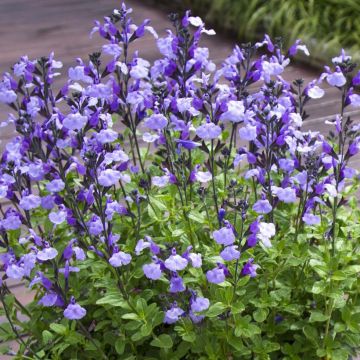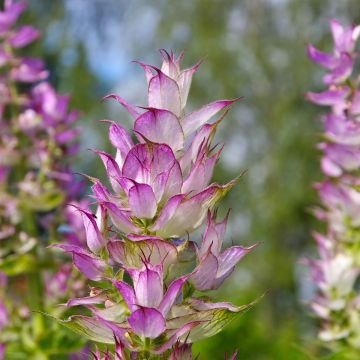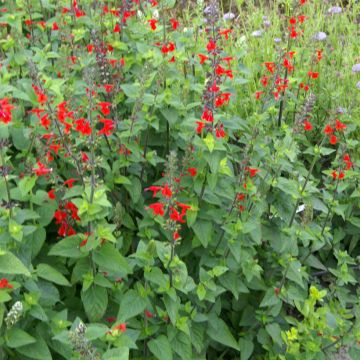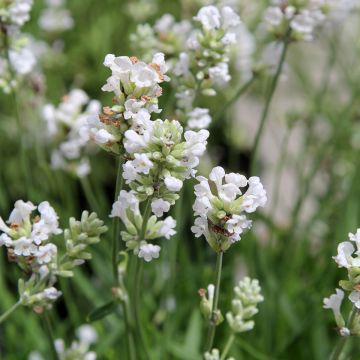

Salvia sclarea Vatican White


Salvia sclarea Vatican White


Salvia sclarea Vatican White


Salvia sclarea Vatican White


Salvia sclarea Vatican White
View more pictures
Hide images

Elise S.

No text to translate.
Elise S. • 59 FR

Valerie D.

N/A - ST PIERRE JUNE 2016
Valerie D. • 27 FR
Salvia sclarea Vatican White
Salvia sclarea Vatican White
Turkestan Clary, Clary sage, Clear eye, Eyebright, Clary wort, See-bright
Perfect -
Hélène, 23/05/2023
Special offer!
Receive a €20 voucher for any order over €90 (excluding delivery costs, credit notes, and plastic-free options)!
1- Add your favorite plants to your cart.
2- Once you have reached €90, confirm your order (you can even choose the delivery date!).
3- As soon as your order is shipped, you will receive an email containing your voucher code, valid for 3 months (90 days).
Your voucher is unique and can only be used once, for any order with a minimum value of €20, excluding delivery costs.
Can be combined with other current offers, non-divisible and non-refundable.
Home or relay delivery (depending on size and destination)
Schedule delivery date,
and select date in basket
This plant carries a 12 months recovery warranty
More information
We guarantee the quality of our plants for a full growing cycle, and will replace at our expense any plant that fails to recover under normal climatic and planting conditions.
Would this plant suit my garden?
Set up your Plantfit profile →
Description
Salvia sclarea 'Vatican White' is a beautiful white-flowered form of clary sage, a medicinal plant. It is an imposing biennial sage, sometimes cultivated as a perennial. In spring, it displays giant panicles of small white flowers highlighted by large white and green pearly bracts that play with the light. All parts of the inflorescence are glandular and aromatic, richly endowed with a fragrant essential oil. Easy to grow in sunny and well-drained soil, clary sage can self-seed abundantly in the garden.
Clary sage is a plant of the Lamiaceae family, native to southern Europe, North Africa, and Central Asia. 'Vatican White' is a white-flowered selection introduced in 2002. It is theoretically a perennial plant, but it often behaves as a biennial, dying after producing too many seeds in its second year of existence. It first develops a large rosette measuring 60 to 80cm (24 to 32in) in diameter, which is evergreen in winter. It is composed of thick, entire, dark green and pubescent leaves, 15 to 25cm (6 to 10in) long. They release a penetrating fragrance reminiscent of musk and grapefruit when touched. In June-July, or even earlier depending on the climate, strong ramified inflorescences emerge from the rosette, rising up to 1m (3ft) from the ground, slowly unfurling their quadrangular stems loaded with a profusion of flowers. The small flowers, 2 to 3cm (1in) long, are creamy-white, enhanced by highly decorative pearly white bracts with green tints. The flowering is followed by the formation of small, fine, dark-coloured seeds. If allowed to go to seed, the plant may die. Simply remove the faded inflorescences to prolong its life and prevent it from self-seeding everywhere.
In Haute Provence, clary cage is planted among lavender plants, creating a bright and fragrant scene under the scorching June sun. One can take inspiration from this in the garden, planting it with thyme, common sage, grey artemisias, and the vibrant blooms of shrubby salvias. This spectacular plant will illuminate a whole bed of perennials and complements the flowering of old roses. If allowed to self-seed, it will fill all the empty spaces in the flower beds. It is a magnificent plant when isolated. It also suits white flower beds. The leaves can be safely used to flavour soups, meats, and game.
Long renowned for its medicinal properties, clary sage is grown for its essential oil which is use in phytotherapy and perfumery.
Salvia sclarea Vatican White in pictures


Flowering
Foliage
Plant habit
Botanical data
Salvia
sclarea
Vatican White
Lamiaceae
Turkestan Clary, Clary sage, Clear eye, Eyebright, Clary wort, See-bright
Cultivar or hybrid
Other Salvia - Sage
View all →Planting and care
Salvia sclarea 'Vatican White' prefers full sun but can also tolerate partial shade. Place it sheltered from cold and drying winds in light, well-drained, rather chalky and dry soil. Space 40cm (16in) apart, as it does not like root competition. It is sensitive to winter moisture, as it can lead to root and stem rot. It does not require a large amount of water, so limit watering. After flowering, prune the plant by cutting it back to about 20cm (8in) from the ground to encourage new shoots the following year. Do not cut off the faded stems, as it will self-seed abundantly. However, seed production exhausts the plant, reducing its lifespan.
Planting period
Intended location
Care
Planting & care advice
-
, onOrder confirmed
Reply from on Promesse de fleurs
Similar products
Haven't found what you were looking for?
Hardiness is the lowest winter temperature a plant can endure without suffering serious damage or even dying. However, hardiness is affected by location (a sheltered area, such as a patio), protection (winter cover) and soil type (hardiness is improved by well-drained soil).

Photo Sharing Terms & Conditions
In order to encourage gardeners to interact and share their experiences, Promesse de fleurs offers various media enabling content to be uploaded onto its Site - in particular via the ‘Photo sharing’ module.
The User agrees to refrain from:
- Posting any content that is illegal, prejudicial, insulting, racist, inciteful to hatred, revisionist, contrary to public decency, that infringes on privacy or on the privacy rights of third parties, in particular the publicity rights of persons and goods, intellectual property rights, or the right to privacy.
- Submitting content on behalf of a third party;
- Impersonate the identity of a third party and/or publish any personal information about a third party;
In general, the User undertakes to refrain from any unethical behaviour.
All Content (in particular text, comments, files, images, photos, videos, creative works, etc.), which may be subject to property or intellectual property rights, image or other private rights, shall remain the property of the User, subject to the limited rights granted by the terms of the licence granted by Promesse de fleurs as stated below. Users are at liberty to publish or not to publish such Content on the Site, notably via the ‘Photo Sharing’ facility, and accept that this Content shall be made public and freely accessible, notably on the Internet.
Users further acknowledge, undertake to have ,and guarantee that they hold all necessary rights and permissions to publish such material on the Site, in particular with regard to the legislation in force pertaining to any privacy, property, intellectual property, image, or contractual rights, or rights of any other nature. By publishing such Content on the Site, Users acknowledge accepting full liability as publishers of the Content within the meaning of the law, and grant Promesse de fleurs, free of charge, an inclusive, worldwide licence for the said Content for the entire duration of its publication, including all reproduction, representation, up/downloading, displaying, performing, transmission, and storage rights.
Users also grant permission for their name to be linked to the Content and accept that this link may not always be made available.
By engaging in posting material, Users consent to their Content becoming automatically accessible on the Internet, in particular on other sites and/or blogs and/or web pages of the Promesse de fleurs site, including in particular social pages and the Promesse de fleurs catalogue.
Users may secure the removal of entrusted content free of charge by issuing a simple request via our contact form.
The flowering period indicated on our website applies to countries and regions located in USDA zone 8 (France, the United Kingdom, Ireland, the Netherlands, etc.)
It will vary according to where you live:
- In zones 9 to 10 (Italy, Spain, Greece, etc.), flowering will occur about 2 to 4 weeks earlier.
- In zones 6 to 7 (Germany, Poland, Slovenia, and lower mountainous regions), flowering will be delayed by 2 to 3 weeks.
- In zone 5 (Central Europe, Scandinavia), blooming will be delayed by 3 to 5 weeks.
In temperate climates, pruning of spring-flowering shrubs (forsythia, spireas, etc.) should be done just after flowering.
Pruning of summer-flowering shrubs (Indian Lilac, Perovskia, etc.) can be done in winter or spring.
In cold regions as well as with frost-sensitive plants, avoid pruning too early when severe frosts may still occur.
The planting period indicated on our website applies to countries and regions located in USDA zone 8 (France, United Kingdom, Ireland, Netherlands).
It will vary according to where you live:
- In Mediterranean zones (Marseille, Madrid, Milan, etc.), autumn and winter are the best planting periods.
- In continental zones (Strasbourg, Munich, Vienna, etc.), delay planting by 2 to 3 weeks in spring and bring it forward by 2 to 4 weeks in autumn.
- In mountainous regions (the Alps, Pyrenees, Carpathians, etc.), it is best to plant in late spring (May-June) or late summer (August-September).
The harvesting period indicated on our website applies to countries and regions in USDA zone 8 (France, England, Ireland, the Netherlands).
In colder areas (Scandinavia, Poland, Austria...) fruit and vegetable harvests are likely to be delayed by 3-4 weeks.
In warmer areas (Italy, Spain, Greece, etc.), harvesting will probably take place earlier, depending on weather conditions.
The sowing periods indicated on our website apply to countries and regions within USDA Zone 8 (France, UK, Ireland, Netherlands).
In colder areas (Scandinavia, Poland, Austria...), delay any outdoor sowing by 3-4 weeks, or sow under glass.
In warmer climes (Italy, Spain, Greece, etc.), bring outdoor sowing forward by a few weeks.




























































